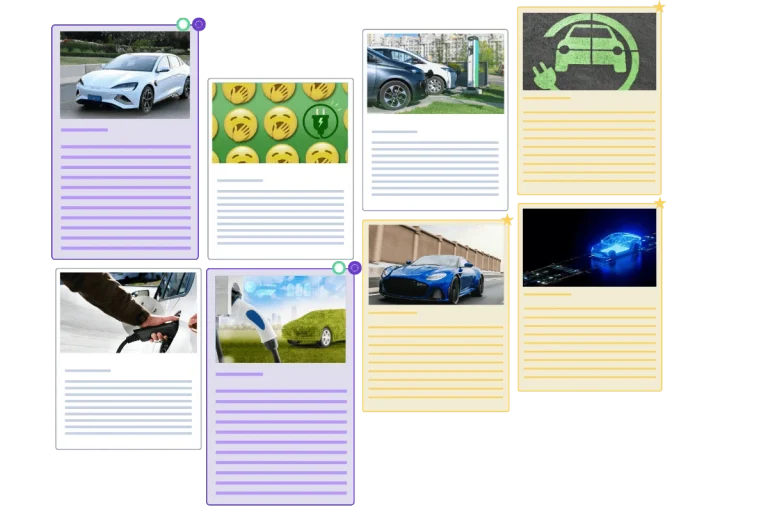Cikisi and Ixxo join forces to deliver even more powerful strategic intelligence! 🚀 Discover how this merger strengthens our expertise and solutions.
Manufacturing industry: 4 key axes
Trends to watch
Context : All over the world, companies are facing talent shortages, a lack of specific technical skills, fragile supply chains… and to address these challenges, many are turning to digital alternatives to build resilience.
The manufacturing industry in particular is undergoing a period of rapid transformation driven by digitalization, and in this changing landscape, intelligence teams play a key role: identifying weak signals, anticipating changes, and supporting decision-making.
First the covid-19 crisis, and now the war in Ukraine, have significantly disrupted and continue to disrupt global supply chains. Long centered around offshoring for cost reasons, many companies are now reassessing their strategies. The rising wages in historically attractive countries and the growing logistical instability have led them to re-evaluate risks. Result: firms are seeking to bring production closer to home, diversify their suppliers, and strengthen their autonomy (VKS).
🕵️♂️ For intelligence teams, this means monitoring the entire value chain: mapping new industrial players, identifying alternative suppliers, tracking competitors’ reshoring movements, and keeping an eye on regulatory developments and local instabilities.
Check out our Competitive Intelligence use case and see why Cikisi is your ally: 👉 Click here
Technology continues to evolve, especially in industrial operations where constraints are multiplying: product customization needs, cost and time reductions, workforce and material shortages, environmental regulations… To respond quickly to market changes, organizations must innovate and automate. AI, IoT, machine learning, cloud computing, ERP… are all technological building blocks that optimize data flows with real-time control. Result: a more flexible, efficient and sustainable production environment (Forbes).
🛰️ Tracking technological innovations, patent filings, or competitors’ strategic initiatives (investments and partnerships) becomes essential to anticipate industry shifts and adapt accordingly.
Read also our article on innovation patent applications: 👉 Click here
If we take France for example, its industrial emissions dropped significantly between 1990 and 2019 (from 139.3 to 76.3 MtCO2e), yet the industry sector still ranks as the third-largest national CO2 emitter. In this context, the manufacturing sector is under pressure to decarbonize its operations – the carbon footprint assessments that companies must conduct are pushing them to evaluate their impact and consider strategies to reduce it while maintaining competitiveness and productivity. This drives organizations to rethink processes, materials, and energy sources to use (Global Climate Initiatives).
🌱 A platform like Cikisi enables, in this case, Strategic Intelligence teams to monitor the sustainability commitments of competitors, partners and suppliers, stay up to date with new low-carbon standards, and understand societal expectations influencing buyer decisions.

Artificial Intelligence technologies are now well known for their ability to analyze large data flows from production machinery to improve machine efficiency and reduce downtime as well as maintenance costs. At the same time, it helps ensure high product quality. How does it work? Using historical data on the equipment it analyzes, the AI system can anticipate issues or failures, suggest improvements, and autonomously adjust the manufacturing process. Typically, we talk about predictive maintenance. But in manufacturing, AI does much more: digital twin modeling, cobots (collaborative robots), large-scale personalization, stock management… it wears many hats (IBM)!
Most importantly, AI analyzes large volumes of external data to detect events that could affect production such as new regulations, market evolutions, political tensions, supplier situations…
📊 For monitoring teams, AI becomes a true co-pilot and this is where solutions like Cikisi, powered by AI, demonstrate their value: they help manufacturers anticipate rather than endure. AI automatically sorts data and monitors markets by detecting weak signals of potential disruptions, and alerts decision-makers early.
Discover the Cikisi’s chatbot: 👉 Ask Mila
Learn more: the use of AI in the manufacturing industry
In 2025, Strategic Intelligence teams in the industry can no longer rely on occasional or manual monitoring. They must leverage tools like Cikisi to conduct continuous, structured and actionable monitoring, in order to enlighten the strategy and support critical decision-making.
Contact us now and discover our all-in-one solution: 👉 Request a demo